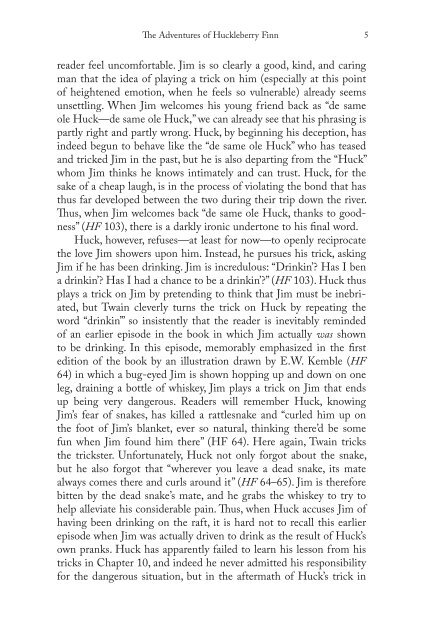Blooms Literary Themes - THE TRICKSTER.pdf - ymerleksi - home
Blooms Literary Themes - THE TRICKSTER.pdf - ymerleksi - home
Blooms Literary Themes - THE TRICKSTER.pdf - ymerleksi - home
Create successful ePaper yourself
Turn your PDF publications into a flip-book with our unique Google optimized e-Paper software.
Th e Adventures of Huckleberry Finn 5<br />
reader feel uncomfortable. Jim is so clearly a good, kind, and caring<br />
man that the idea of playing a trick on him (especially at this point<br />
of heightened emotion, when he feels so vulnerable) already seems<br />
unsettling. When Jim welcomes his young friend back as “de same<br />
ole Huck—de same ole Huck,” we can already see that his phrasing is<br />
partly right and partly wrong. Huck, by beginning his deception, has<br />
indeed begun to behave like the “de same ole Huck” who has teased<br />
and tricked Jim in the past, but he is also departing from the “Huck”<br />
whom Jim thinks he knows intimately and can trust. Huck, for the<br />
sake of a cheap laugh, is in the process of violating the bond that has<br />
thus far developed between the two during their trip down the river.<br />
Th us, when Jim welcomes back “de same ole Huck, thanks to goodness”<br />
(HF 103), there is a darkly ironic undertone to his fi nal word.<br />
Huck, however, refuses—at least for now—to openly reciprocate<br />
the love Jim showers upon him. Instead, he pursues his trick, asking<br />
Jim if he has been drinking. Jim is incredulous: “Drinkin’? Has I ben<br />
a drinkin’? Has I had a chance to be a drinkin’?” (HF 103). Huck thus<br />
plays a trick on Jim by pretending to think that Jim must be inebriated,<br />
but Twain cleverly turns the trick on Huck by repeating the<br />
word “drinkin’ ” so insistently that the reader is inevitably reminded<br />
of an earlier episode in the book in which Jim actually was shown<br />
to be drinking. In this episode, memorably emphasized in the fi rst<br />
edition of the book by an illustration drawn by E.W. Kemble (HF<br />
64) in which a bug-eyed Jim is shown hopping up and down on one<br />
leg, draining a bottle of whiskey, Jim plays a trick on Jim that ends<br />
up being very dangerous. Readers will remember Huck, knowing<br />
Jim’s fear of snakes, has killed a rattlesnake and “curled him up on<br />
the foot of Jim’s blanket, ever so natural, thinking there’d be some<br />
fun when Jim found him there” (HF 64). Here again, Twain tricks<br />
the trickster. Unfortunately, Huck not only forgot about the snake,<br />
but he also forgot that “wherever you leave a dead snake, its mate<br />
always comes there and curls around it” (HF 64–65). Jim is therefore<br />
bitten by the dead snake’s mate, and he grabs the whiskey to try to<br />
help alleviate his considerable pain. Th us, when Huck accuses Jim of<br />
having been drinking on the raft, it is hard not to recall this earlier<br />
episode when Jim was actually driven to drink as the result of Huck’s<br />
own pranks. Huck has apparently failed to learn his lesson from his<br />
tricks in Chapter 10, and indeed he never admitted his responsibility<br />
for the dangerous situation, but in the aftermath of Huck’s trick in

















